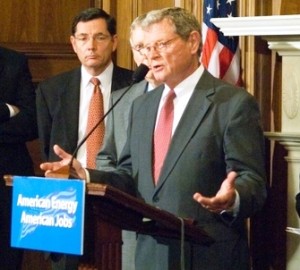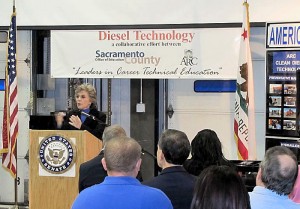Harsh things were said about the damaging health effects created by the burning of diesel fuel at a Senate Environment and Public Works Committee meeting this week.
The comments of Barbara Boxer, chairman (D-CA), against diesel, and differing observations of the ranking member, James Inhofe (R-OK), favoring natural gas appear to be the beginning of a renewed push for expanded use of this relatively clean fuel in some transportation applications.
The Environment and Public Works Committee’s is looking at ways to use the next surface transportation bill to improve our nation’s energy security and the environment. Its jurisdiction includes responsibility for addressing global warming, and it has responsibility for legislation related to transportation systems.
Leaving politics aside, at stake is U.S. energy independence, as well as how your tax dollars are used to subsidize types of energy use.
“Making our transportation system more efficient and reducing oil consumption can help to make our country less dependent on countries that don’t like us. Our transportation system’s reliance on fossil fuels also contributes significantly to air pollution that is harmful to public health and the environment,” said Boxer in her opening remarks.

Heavy-duty trucks and buses, and non-road sources make up 42% of all transportation related greenhouse gas emissions.
Roughly, two thirds of all the oil consumed in this country is used for transportation. Heavy-duty trucks and buses, and non-road sources make up 42% of all transportation greenhouse gas emissions in the United States. Significant growth in these areas is predicted.
Moreover, the latest figures from the U.S. Department of Energy’s Energy Information Administration (EIA), the U.S. imported 59% of its oil, or 322 million barrels in February 2010, sending about $25 billion, – or more than $600,000 a minute – to foreign countries. Since January 2009, the U.S. has imported more than five billion barrels of oil as our politicians postured about energy independence. This debate, of course, goes all the way back to the Carter Administration. (Click here for the sorry record our alleged “leaders” have compiled on energy security and independence.)
“Diesel exhaust contributes to asthma attacks, bronchitis and other respiratory illness, heart disease, permanent harm to the lungs of children and cancer. In fact, diesel exhaust contains more than 40 cancer-causing substances, according to the California Air Resources Board,” Boxer added.
Inhofe took a different, but potentially complimentary tack – if you can believe that Republicans will work with Democrats on anything, and vice versa, for the common good, as opposed to partisan political gain.
“One innovative way to achieve that goal (energy independence) is through greater use of natural gas-powered vehicles,” Inhofe said, replying to Boxer.
“In 2008, when gasoline prices were above $4 per gallon, I was the first in Congress to introduce a comprehensive bill to promote the use of natural gas as a realistic alternative for the many Americans who were looking for price relief,” Inhofe said, not without self interest. “The bill I introduced was called the “Drive America on Natural Gas Act.”
What strikes me here is the seeming public agreement of Boxer – a fanatical global warming proponent, “one of the greatest challenges of our generation” – and Inhofe – a fanatical global warming opponent, “greatest hoax ever perpetuated on the American people” – over the benefits of natural gas.
What is going on behind the scenes is, as always, difficult to surmise, but natural gas is an excellent fuel in many ways, and it makes sense to encourage its use. The questions are how, and in what applications? (Only Honda currently sells a compressed natural gas car.)
Natural gas contains less carbon than any other fossil fuel, and, therefore, produces lower CO2 emissions per vehicle mile. However, burning it produces methane, another principal greenhouse gas. Methane traps more than 20 times as much heat as carbon and accelerates climate change. Proponents claim that the increase in methane emissions is offset by a substantial reduction in CO2 emissions compared to other fuels.
The California Air Resources Board (CARB) in a study concluded that burning compressed natural gas produces about 22% less GHGs than burning diesel, and 29% less than burning gasoline.
However, EPA finalized the first-ever mandatory greenhouse gas reporting requirement in October of 2009. That rule required 31 industry sectors, covering 85% of total U.S. GHG emissions, to track and report their emissions.
In addition to those 31 industries, the agency is now proposing to collect emissions data from the oil and natural gas sector, industries that emit fluorinated gases, and from facilities that inject and store carbon dioxide (CO2) underground for the purposes of geologic sequestration or enhanced oil and gas recovery. Methane is the primary GHG emitted from oil and natural gas systems, while fluorinated gases are even stronger and can stay in the atmosphere for thousands of years.
Data collected from facilities that inject CO2 underground would enable EPA to track the amount of CO2 that is injected and in some cases require a monitoring strategy for detecting potential emissions to the atmosphere.
About the only aspect of this not subject to technical and political debate is the supply of natural gas. One assessment shows that the U.S. has 2,047 trillion cubic feet of natural gas. At current usage rates – and barring future government intervention – this is enough natural gas to meet demand for about 100 years or 50 Congressional election cycles.
The natural application choice appears to be heavy trucks and buses. According to the U.S. Department of Energy, the average consumer clocks about 12,000 miles per year, using roughly 500 gallons of gasoline.
Large, medium- and heavy-duty trucks consume much more fuel on an individual basis. An 18-wheel tractor-trailer drives say 120,000 miles per year at 6 miles per gallon or 20,000 gallons of diesel fuel per year. As a result, trucks and buses consume about a quarter of the on-road energy – mostly in the form of diesel fuel that Boxer so dislikes.
There are many alternative fuel and advanced technology options now competing for the light-duty market and your tax subsidy dollars – natural gas, propane, ethanol, electricity, plug-in electrics, among others. Nevertheless, for diesel-powered trucks and buses, the options come down to two practical choices – natural gas and biodiesel.
Biodiesel is a good fuel with, arguably, limited potential. Existing diesel vehicles cannot use blends of more than 20% biodiesel and most only use 5%. The availability of domestically produced feedstocks – mostly soybeans – for biodiesel production is also limited.
Most of the major truck and bus manufacturers already offer natural gas models. Natural gas buses cost $40,000 – $50,000 more than diesel buses, though. Moreover, in a typical 18-wheel application, the added cost could be as high as $80,000. The up-front cost is paid back over time since natural gas is currently priced at retail at about $2.00 per gallon equivalent of gasoline. (Depending on local taxes.)
Richard Kolodziej, president of NGVAmerica, who testified before the Committee said that the most effective immediate action Congress could take was passing the “New Alternative to Give Americans Solutions” (NAT GAS) Act (S. 1408). It was introduced last July and was referred to the Senate Finance Committee.
It changes the Internal Revenue Code to allow:
- an excise tax credit through 2019 for alternative fuels and mixtures using compressed or liquefied natural gas;
- a modified income tax credit through 2019 for alternative fuel motor vehicles powered by compressed or liquefied natural gas;
- an offset against the alternative minimum tax (AMT) for tax credits for alternative fuel motor vehicles and refueling property and provide for the transferability of such credits;
- a tax credit through 2019 for investment in natural gas vehicle project bonds;
expensing of property used to make vehicles fueled by compressed or liquefied natural gas - a tax credit through 2019 for alternative fuel vehicle refueling property for compressed or liquefied natural gas.
It also mandates that federal agencies purchase dedicated alternative fuel vehicles for their fleets unless they can show that alternative fuel is unavailable or this is impractical.
There are big dollars – your dollars – involved here.


My experience with CARB tells me that anything and everything they want is the wrong thing. No more analysis required. Everything they have advocated to date has been bad.
Mary Nichols, who runs it, has turned CARB into a mechanism to clean the air in California by clamping down on civilization.
I heard an interesting metaphor about it: “It’s pointless to stop California from peeing in the shallow end of the pool while China is busy peeing in the deep end.”
Oh, by the way, Global Warming was a hoax. Al Gore is a con man. Embrace the reality of it.
Thanks for reading.
JM: CARB’s data are good. The policy decisions it has made is a different matter entirely. Right now there are a number of bills – proposing to use your tax dollars – wending their way through Washington. That was the point of my piece – to follow your money. – KZ, editor
Miss Barbara doesn’t know that gasoline vehicles aren’t even tested for the particulates she complains about from diesels. She doesn’t know that most of the particulates in CARB testing of modern diesel engines are not any different overall from total particulates emitted by ULEV gasoline engines when you take into account how the gasoline is made and how it evaporates much more easily. Barbara Boxer couldn’t care less about your lungs or mine. If she did, she would push for testing of gasoline vehicles and bash them just as much. She would also put down the entire trucking industry and miss the fact that clean ultra low sulfur diesel and better yet bio-diesel is likely the most clean, lowest carbon-causing fuel there can be.
But do Californians care enough? Don’t know. She has been a political hack for a long time and she gets re-elected.